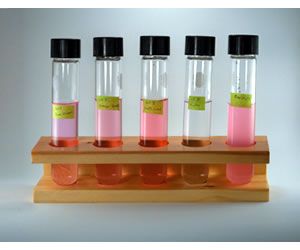When contributor Drew Frye commissioned his family’s PDQ 32 catamaran six years ago, his daughter asked, What are these pink lumps in the sink, Dad? The toilet bowl was even more spectacular, a science project in a dozen hues of pink, green, yellow, and black. The boat had been winterized for some time, down in south Chesapeake Bay, where winters are mild and many boaters and don’t take freezing seriously.
The previous owner-or rather the owners contractor-had gone light on the propylene glycol, and bacteria had multiplied, filling the water systems with viscous goo. Fortunately, the freshwater tank and hot water heater had been emptied rather than filled with antifreeze, so the trouble was confined to some piping. A little scrubbing, disinfecting, and rinsing cleared the plumbing, but it took years before his wife was comfortable drinking from the tap.
Winterizing seems simple enough. Add enough glycol to protect against bursting to the lowest temperature you are likely to see. Since the jugs of propylene glycol (PG) proclaim burst points of -50 degrees to -100 degrees Fahrenheit, common sense suggests that only a dash should be needed. Most boaters don’t test the discharge for glycol; they just check the color and assume all is well. We recently addressed burst point (see Practical Sailor October 2014 online) and corrosion protection (Practical Sailor September 2014 online) in anti-freeze and coolants, and during the course of those tests, we noticed a clear link between winterizing procedures and biological contamination.
The bad news (good news for the environment) is that all three of the typical formulas found in winterizing chemicals-propylene glycol (PG), and ethylene glycol (EG), and ethanol-are all completely biodegradable. To yeast and bacteria, they are simple sugar-like molecules-a perfect food, as long as the concentration is not too great.
In his day job, Frye has used waste glycol and alcohol to feed the bacteria used in advanced waste-water treatment plants. Fortunately, higher glycol concentrations have the opposite effect. At 20 percent concentration, all three formulas (PG, EG, and ethanol) inhibit the growth of bacteria and yeast. At a 30-percent concentration, they will kill any growth.
Contamination and pH
Maintaining a relatively high pH level is also important to fighting growth in the water systems during winter storage. Bacteria are generally happiest between 5.5 and 6.5, and mold and fungus are happiest between 5 and 6. There are organisms that love low pH, living on sulfuric acid drips; cholera prefers a pH of 9 under anaerobic conditions. But these are exceptions, and most microorganisms can be prevented with a pH less than 3 or greater than 9.
Low pH is of little use for winterizing fluids and engine coolants; corrosion becomes severe, as demonstrated by our tests of vodka and Camco Arctic Ban, which have a pH ranging from 4 to 5. High pH, on the other hand, is useful in controlling iron corrosion, and all of the other winter products and engine coolants we have recommended have a pH of 9 to 9.5. If used as recommended, they should be resistant to infection. However, if diluted, the pH drops and this protection will be lost as well.
Just as a potable water systems can be infected, so can your engine. Bacteria and yeast aren’t just unsanitary; they make the water sour, often as acidic as vinegar. In potable water systems, this causes inconvenience and disgust, but in engine systems, severe damage is possible. Frye has opened heat exchangers with weak glycol that smelled of aerobic fermentation-like the proverbial half-open bottle of red wine that was lost behind the couch-and found the inside clogged with bright red rust, the zinc long gone, and the engine block severely damaged, with pitting under gasket edges throughout. The pH dropped to 4.3, and corrosion was significant.
Boats present different scenarios than cars; every time the car is driven the cooling system gets hot and the glycol is sterilized, but not so for the boat in storage. According to Dow Chemical, one of the worlds largest producers of glycol, 50 percent of systems with 10-20 percent glycol become infected, and all systems with less than 10 percent glycol eventually become infected. Systems with 25 percent glycol will remain effectively sterile.
For this test we wanted to explore contamination in more depth. Are there differences between brands or between glycols and ethanol? At what concentration are we safe from bacterial growth? What pH? Our answers changed the way we think about winterizing.
What We Tested
Safety Note: Ethylene glycol should NEVER be used in a potable water system. We have tested EG in this article solely to establish if it might promote biological growth in engines, and if so, what minimum concentration is safe.
Since we have already reviewed a good list of winterizing products and engine coolants, we have stayed with that same product list. We did not explore the effect of biological growth on corrosion, although we know that bacterial enzymes can promote it. Because the relatively large corrosion coupons used for testing included natural biocides copper and zinc, such an analysis would be fraught with variables .
We added small amounts of borax to certain formulas. Commonly used as a corrosion inhibitor in engine coolants, as a mild biocide in HVAC (air conditioning systems) glycol coolants, and as a mild anti-bacterial used for mildew prevention, we thought it might help. Borax, once a common food additive, has since been banned, but since antifreeze is rinsed out, we see no concern. We also added small amounts of caustic to specific samples to isolate pH affects from additive chemistry.
Observations
Many winterizing products tested showed traces of infection when diluted below 20 percent glycol. All the products did well at recommended dosages (-50 F burst point products range from 26 percent to 31 percent glycol or alcohol).
The ethanol formulas were no better at sterilizing than the glycol formulas. Both can harm certain plastics and elastomers; overall, ethanol presents a slightly greater risk. Both became unspeakably foul if diluted below 10 percent ethanol or glycol content. Bugs seemed to feast upon the vodka formula, which chemically falls in the ethanol group.
Knowing from our mildew prevention test that borax can help inhibit growth (see Practical Sailor November 2013 online), we added borax (250 parts per liter) to diluted samples of pure ethylene glycol and Camco Arctic Ban, two formulas that when diluted had consistently became infected during our tests. The result was remarkable, but not too surprising. The borax completely inhibited growth.
Although the bio-resistance can be partly attributed to the increased pH, our findings are consistent with studies of automotive coolants showing that formulas with borax (a common buffer and corrosion inhibitor) have a resistance to microbial contamination beyond that attributable to increased pH alone.
While it is too early to suggest you ought to add borax to winterizing fluids-anything that is added to a potable water system should be subject to more rigorous investigation-we think the vendors should look into the potential for more infection-resistant yet non-toxic winterizing fluids.
The effects of increased pH levels were obvious. Again using bio-friendly diluted formulas of ethylene glycol and Camco Arctic Ban, our testers added sodium hydroxide to raise the pH. Biological growth was completely inhibited. While some microorganisms can grow at this pH, our experience is that all commonly occurring microorganisms will be inhibited. Again, we are not suggesting that you brew your own potable anti-freeze, just reinforcing that low pH can promote microbial growth.
Product Testing
In addition to the lab testing (above), we tested three products in the boat: Camco Freeze Ban, Pure Oceans -50, and Sudbury Winter Stor -50. During our onboard testing, we used a refractometer to confirm a glycol content of at least 20 percent. At the end of four months all dip slides showed zero colonies, and all rinsed easily with no aftertaste.
Freeze Ban -50 RV and Marine Antifreeze
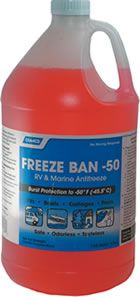
This propylene glycol-based product from Camco is blended with an effective corrosion control formulation, and the higher pH allowed it to resist infection. A much better product than Camcos other product Arctic Ban.
Bottom line: We rate Camco Freeze Ban as the Budget Buy in a -50 F product.
Arctic Ban -50
This is a slightly lower-priced Camco product based on denatured ethanol, instead of glycol. Its low pH made it clearly more vulnerable to infection by fungus. It is safe if used at recommended strength, but risky if diluted. It smelled awful after fermentation.
Bottom line: This product is not recommended.
Southwin RV Antifreeze
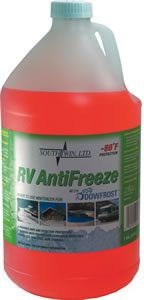
This propylene glycol-based product is labeled as using Dowfrost. This branded chemical from Dow Corning is perhaps the best known corrosion inhibiting PG-based heat transfer fluid in the United States. It is found in most commercial refrigeration and air conditioning systems. In our testing, the Southwin successfully resisted growth.
Bottom line: We rate this as Recommended.
Star brite -50 Marine and RV Antifreeze
A premium propylene glycol product, Star brite -50 provided the best freeze and burst protection of the group in prior testing and resisted growth.
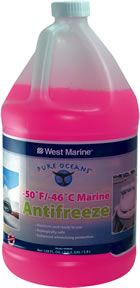
Bottom line: This product is was named as a Best Choice among -50 burst-point products.
Star brite -100 Marine and RV Antifreeze
A more concentrated version with twice the glycol, this product is perfect for boats in extreme climates; the extra glycol compensates for the drained water inevitably left in the plumbing that dilutes anti-freeze. For the price-conscious cruiser, it also offers an opportunity to save a few dollars; simply pour the jug into two matching jugs, fill with water, and you have two gallons of -50 burst point winterizing fluid. We didnt re-test this product for this article; we have no reason to expect performance different from Star brite -50.
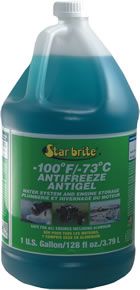
Bottom line: This is Budget Buy for those willing to do a little extra mixing and Best Choice among -100 F products.
Pure Oceans -100 Marine Antifreeze
This concentrated version from West Marine has twice the glycol of its -50 product and is perfect for boats in extreme climates. The extra glycol compensates for any remnant water. As with the other -100 products you can save some money by diluting it 50 percent with water to make two gallons -50 burst point winterizing fluid. We did not re-test for this article; we have no reason to expect performance different from Pure Oceans -50.

Bottom line: This product is Recommended and offers good value if you don’t mind some mixing.
Sudbury Winter Gard -50
A premium propylene glycol product, Sudbury performed very well in burst point and corrosion testing. It also resisted growth.
Bottom line: Testers gave this a Recommended rating.
Sudbury Winter Gard -100
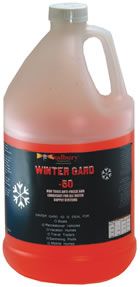
Sudburys premium propylene glycol product, Winter Gard -100 performed very well in burst point and corrosion testing. Like Pure Oceans and Star brite -100 products, it contains twice the glycol content, and is thus suitable for colder climates and economical in warmer climates if diluted 50/50 with water. This is another favorite of ours. We did not re-test it, but we expect performance to match that of Winter Gard -50.
Bottom line: Easy to find, this product is Recommended.
Winter Stor -50, Sudbury
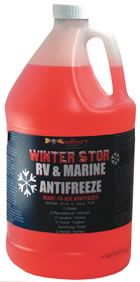
This ethanol/PG blend product had a higher pH than other ethanol based products. However, the corrosion protection was mediocre and the resistance to growth somewhat less, revealing the shortcoming of ethanol blends.
Bottom line: There are better products in this category.
Skol Vodka
Some sailors swear by cheap vodka as a winterizing agent, but this one failed to impress us. Advocates claim that vodka leaves less aftertaste in the plumbing than glycols and that it does not become infected with bacteria and yeast. Unfortunately, this is simply not true. The low initial pH made it very vulnerable to infection by fungus when diluted. As an anti-freeze, this is only safe if used nearly straight-up, which would be flammable, expensive, and corrosive.
Bottom line: Not recommended.
Conclusions
There is little doubt in our minds that microbial infection is what causes most fouling of water systems. In boats winterized with alcohols and glycols, it became clear that under-treatment was a leading cause of infection. The combination of weak solution and mild temperatures in fall and spring proved especially hospitable to growth.
Much of your winterizing success will depend on the initial condition of your existing water system. If it is nearly sterile (effectively chlorinated water), there may be too few bacteria and fungus present for infection to start. However, if you use less than 20 percent alcohol or glycol (after dilution with water left in the system) you are at risk of biological growth; the lower the concentration the greater the risk. Vodka and other alcohol-based winterizing fluids should be avoided.
The alkalinity (pH) seems to correlate with infection resistance, although this depends on the microorganism types. Although high pH has long been used as an antimicrobial defense in industrial systems, we are not suggesting you add anything to change the pH. This might affect the formulas ability to fight corrosion.
However, pH is certainly a factor that can be monitored using simple dip sleeves used for pool or aquarium maintenance. If you find the pH goes below 7, theres likely a problem. At that level, glycol-treated potable water systems might be infected, and glycol-treated cooling systems may be experiencing exhaust leaks or certain electrolysis problems.
Time and temperature make a difference. Our warm incubator temperatures encouraged growth. Boats winterized only during the coldest months of winter will have fewer problems with growth.
There is evidence that winterization products could be improved with additives. We are not suggesting regular use of DIY formulations for potable water systems, but perhaps the vendors can be encouraged to investigate biocides that are non-toxic to humans. Well see.
Antifreeze
| PRODUCT | PRICE | PRICE / GALLON GLYCOL | ANTIFREEZE AGENT | FREEZE POINT* | GLYCOL CONTENT** | BURST PROTECTION | CORROSION PROTECTION | ANTIGROWTH |
|---|---|---|---|---|---|---|---|---|
| CAMCO ARTIC BAN-50 | 4.55 | 17.5 | Ethanol | 21 degrees | 26%** | Good | Fair | Excellent |
| CAMCO FREEZE BAN-50 | 4.7 | 16.79 | Propylene glycol | 11 degrees | 0.28 | Good | Excellent | Excellent |
| WEST MARINE PURE OCEANS-50 MARINE | 5.99 | 19.97 | Propylene glycol | 8 degrees | 0.3 | Good | Excellent | Excellent |
| STAR BRITE ANTIFREEZE ANTIGEL-50 | 5.99 | 19.32 | Propylene glycol | 7 degrees | 0.31 | Excellent | Excellent | Excellent |
| SUDBURY WINTER GARD-50 | 5.99 | 19.97 | Propylene glycol | 8 degrees | 0.3 | Good | Excellent | Excellent |
| SUDBURY WINTER STOR-50 | 5.49 | 17.71 | Propylene glycol / ethanol | 7 degrees | 0.31 | Good | Fair | Fair |
| SOUTHWIN RV ANTIFREEZE-50 WITH DOWFROST | 5 | 17.86 | Propylene glycol | 11 degrees | 0.28 | Good | Excellent | Not Tested |
| VODKA | 12.75 | 60.32 | Ethanol | 17 degrees | 0.4 | Good | Poor | Poor |
| SUDBURY WINTER GARD-100 | 9.79 | 15.79 | Propylene glycol | 8 degrees (diluted 50%) | 0.62 | Good | Excellent | Not Tested |
| STAR BRITE ANTIFREEZE ANTIGEL-100 | 8.5 | 14.17 | Propylene glycol | 8 degrees (diluted 50%) | 0.6 | Good | Excellent | Not Tested |
| WEST MARINE PURE OCEANS-100 MARINE | 14.99 | 24.18 | Propylene glycol | 7 degrees (diluted 50%) | 0.62 | Good | Excellent | Not Tested |
| *Temperatures measured in Fahrenheit | **Refractive index scale |
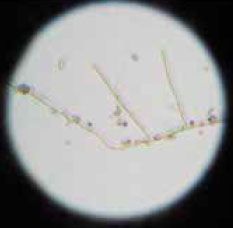
When testing a chemical’s toxicity and its ability to biodegrade, a common procedure is to dilute each target chemical at various ratios of interest, and then to inoculate each with an acclimated microbiological seed. For our test, the seed was developed by filling a five-gallon bucket with several gallons of water and a weak mixture (two percent total glycol content) of all of the winterizing agents to be tested.
The bucket was left in a partially covered cockpit—enough to keep bird droppings out but admit dust and spores—for five days during early winter and then incubated in a warm, dark location for one month. During this period we gradually added increasing amounts of each of the products to be tested, eventually reaching 15 percent total glycol and ethanol, in an effort to acclimate the bugs to high concentrations of winterizing agents. The exact composition of the seed is a major variable in this sort of testing, and results will likely vary seasonally and regionally.
Each product dilution of 100 milliliters (ml) was then dosed with this 2 ml seed and allowed to incubate at 90 degrees F for another 20 days. At the end of each incubation period, an agar-coated slide was dipped in the dilution and allowed to incubate (again at 90 F) in a sterile tube for an additional five days. At the end of the period, the colonies were counted and recorded.
We also tested several products on board, each in a different portion of the potable water system. After four months, samples were tested by dip slide for contamination and, after rinsing, for aftertaste





























